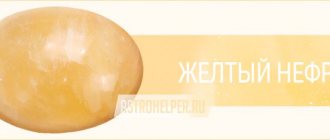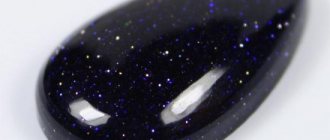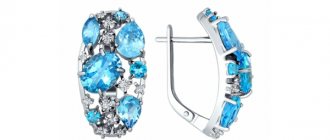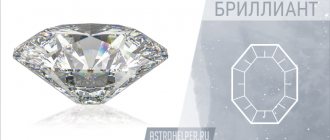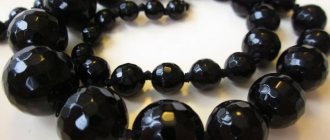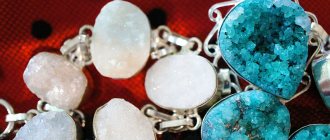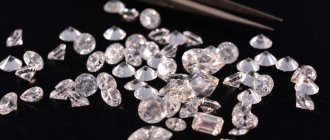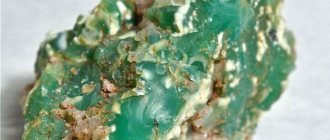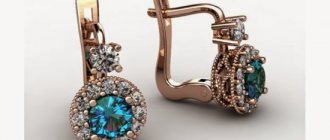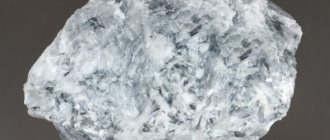| Stone type | Industrial |
| Prevalence (Deposits) | Austria, Spain, Kyrgyzstan, China, Mexico, Russia, Slovenia, USA, Tajikistan, Montenegro |
| Varieties | Metacinnabar, hypercinnamon |
| Transparency | Transparent, translucent |
| Shine | Metal |
| Mohs hardness scale | 2—2,5 |
| Chemical composition | HgS |
| Color | Red |
| Owner's color type | Not found |
| Owner's temperament | Not found |
| Names | Not found |
| Zodiac sign | Taurus |
| Date of Birth | from April 20 to May 20 |
| Chinese horoscope | Not found |
| Element | Earth |
| Planet | Not found |
| Day of the week | Not found |
| Month | Not found |
| Season | Not found |
| Numerology vibration | Not found |
| Chakra | Muladhara |
| What stones is it compatible with? | Not found |
| What stones is it not compatible with? | Not found |
| Therapeutic effect (problems) | Libido, increased tone |
| Therapeutic effect (on organs) | Not found |
| Magic properties | Rationality, finance |
Cinnabar is a stone that attracts attention with its deep red color.
In ancient times it was called "dragon's blood." The mineral is mercury sulfide. However, the stone is not considered fatal to humans. But products made from it are not suitable for daily use.
What it is
Cinnabar is the most common mercury mineral and is a sulfide of mercury. In nature, the mineral appears as granular aggregates. The stone often contains impurities of other chemical elements: selenium, arsenic, antimony, copper.
The scarlet gem has been known to mankind since ancient times. In Ancient Greece, Egypt and Rome, it was used as a raw material for the production of red paint, which was used to decorate paintings, walls, and religious paraphernalia.
What is cinnabar stone?
Cinnabarite, cinnabar, mercury blende, brick or royal ore is a natural mineral of deep bright red, brown-red, gray-red color. Depending on the impurities, it acquires a black-red, almost charcoal color.
The name of the stone translates as “dragon’s blood.” In Rus' it was called the “blood of Christ” because the coloring pigment used by icon painters was obtained from it.
In its raw form, cinnabar appears as a heavy mineral with an uneven surface and interspersed with red crystals. The stone seems to glow from within. In nature, there are samples with a diamond shine and a matte surface.
Main physical characteristics of cinnabarite:
- Increased fragility.
- Low hardness - only 2/10 on the Moss scale.
- Resistance to acids. Cinnabar dissolves only in a mixture of concentrated hydrochloric and nitric acid called aqua regia.
- Fusibility.
- Density – 8-8.2 g/cm3.
- Lead-gray tarnish (irridescent oily film on the surface).
- Transparency or translucency.
- Non-conductivity of current.
- No luminescence.
The specific distinctive quality of such a mineral is the red line.
If you run it across the surface, a clear, bright scarlet stripe will remain.
Physical properties
Cinnabar is a fragile stone characterized by a silvery tint. Its hardness is rated at only 2.5 on the Mohs scale. The density is 8 grams per 1 cm3. Characterized by perfect cleavage. The crystal can be either completely or partially transparent.
The mineral crystals are easily crushed into powder. It melts at a temperature of 200 degrees Celsius. The size of natural cinnabar reaches several centimeters. If you heat the stone to 580 degrees, gray drops of mercury will be released.
Crystal optical properties in thin preparations (sections)
Red cinnabar in thin sections in transmitted light. Pleochroism: orange-red according to Ne, dark red according to No. Single-axis (+). ne - 3.272; no = 2.913 (Na); ne -no = 0.359. It very strongly rotates the plane of polarization (15 times stronger than quartz)10, in plates 0.2 mm thick in red light by 52-58° (according to Decloiseau). Left-hand rotation is predominantly observed; in some crystals, as a result of twinning, areas with right and left rotation are observed, distributed over sectors or irregularly. In polished sections it is bluish-white in reflected light. Reflectivity (in%): for green rays 30, for orange - 25.5, for red - 26. Bi-reflection is noticeable (increases with immersion). Quite a strong anisotropy, but internal reflexes obscure it somewhat. Exceptionally strong blood-red internal effects.
Chemical composition
Cinnabar is mercury sulfide, which may also contain impurities in the form of other chemical elements. In air, the stone oxidizes, and a barely noticeable film of tarnish appears on its surface, having the formula HgO.
Must see: History, properties and meanings of Iceland spar
Cinnabar does not react with nitric and sulfuric acid. Decomposes on contact with sodium or potassium sulfide solution.
Interesting! Due to its mercury content, it is not advisable to keep the stone in private collections. It is unacceptable to keep cinnabar near heating appliances, as well as in places accessible to children and pets. To store stones in a private collection, it is advisable to use sealed glass caps.
How to store and wear jewelry
Cinnabar requires special treatment:
- Jewelry is stored in a closed box, wrapped in soft cloth.
- For storage, choose places away from heating appliances and other heat sources.
- The stone is cleaned only with cool water.
- Jewelry should not be heated.
- Even if the stone fits the Zodiac, it is pleasant to hold in your hands; you need to wear jewelry only with the necessary magical help.
Accessories with synthetic minerals are less dangerous, but you should not overuse them . The rules of use are similar to natural ones.
Red stone decoration
Origin of the stone
The mineral deposits are formed in hydrothermal vents located in hydrothermal vents located near the surface. Nearby there may be deposits of quartz, calcite, barite, pyrite, and galena. Nuggets of pure mercury or gold are less common nearby.
Cinnabar particles may occur in veins near metamorphosed jasperoid rocks that are associated with recent volcanic eruptions or alkaline hot springs.
Colors of the ancient world: cinnabar. Cinnabar is the second red stone after ocher, which attracted the attention of ancient artists….
Published by elementy.ru Wednesday, August 14, 2021
Among the ten most dangerous
Cinnabar is one of the ten most dangerous killer minerals on Earth.
Mercury
In this dark series is galena (lead ore), which affects brain cells; asbestos , which rips apart the lungs with millions of microscopic blades of quartz crystals; gold-like arsenopyrite , containing arsenic; radioactive torburnite , filled with uranium and radon, and several other very dangerous “repeat offender” minerals.
Main deposits
In ancient times, the mercury mineral was mined in Central Asia and Rome. The largest deposits of stone today:
- Idrija (Slovenia);
- Almaden (Spain);
- California, Oregon (USA);
- Avala (Montenegro).
Almaden accounts for over 80% of the total stone production. In Asia, production has been established in such fields as Khaidarkan (Kyrgyzstan) and Dzhizhikrut (Tajikistan). In Russia, cinnabar is mined in Chukotka. The stone is also found in China, Austria, Mexico and other countries of the world.
Do you consider cinnabar stone dangerous because of its mercury content?
VeryNo
Cinnabar in jewelry
The stone is used to create beautiful jewelry:
- beads;
- earrings;
- bracelets;
- brooches;
- medallions;
- rings
Jewelry should be worn carefully due to its high mercury content.
Collectors love the gem. They like to use transparent patterns in their interiors.
What medicinal properties does it have?
The healing properties of cinnabar have been appreciated since ancient times. The mineral powder was used to treat severe infectious diseases. However, due to the mercury content, the stone caused irreparable harm to health upon prolonged contact with the human body.
In modern lithotherapy, cinnabar is not used due to its mercury content. It is especially dangerous to apply heated stones to the body, since with an increase in the temperature affecting cinnabar, mercury vapor is released. Some lithotherapists still use the mineral in healing practices. Thus, contemplation of the stone promotes a surge of energy, increased libido and initiative.
Therapeutic effect
The shamans and healers of antiquity were unaware of the dangerous properties of the mineral, so it was used for many reasons:
- This is the oldest bactericide. The mineral, ground into powder, was used to cure leprosy and syphilis.
- The stone was considered a fast-acting means of restoring strength and was advised to be worn closer to the body.
- Outbursts of rage or problems with the brain were treated with a mineral placed under the pillow.
- This was once a popular ingredient in cosmetics: aristocrats bought whitening creams and ointments to lighten freckles. Cleopatra also used blush made from cinnabar powder and white clay.
Even when the danger of such “cosmetics” became obvious, the ladies of the demimonde and geisha did not change it.
Official medicine does not use the mineral.
Modern lithotherapists recommend it as a stimulus for sexual activity. But crystals should be contemplated, under no circumstances applying to the skin, especially when heated.
Magical Features
In ancient times, cinnabar was associated with drops of dragon blood. Therefore, the stone was endowed with special magical powers. For example, in Ancient Egypt in the 3rd millennium BC, the mineral was used in the manufacture of paint, which was then used in ritual ceremonies. Cinnabar was also used to make small vessels for drinks and potions. However, at that time humanity did not know about the danger of mercury stone.
Decorative items made from cinnabar were popular in China. Red decorative items were also used as talismans and amulets. Products from China were impressive in their variety of shapes and sizes.
Be sure to see: Types and properties of calcite
Taoist monks used tiny amounts of mineral powder in the preparation of longevity elixirs. But after taking this medicine, the person felt chills, dizziness and weakness. These symptoms were mistakenly taken to indicate the effectiveness of drugs that included cinnabar.
Today, a talisman made from the red mineral is recommended for businessmen, bankers, and financiers. The energy of cinnabar helps you focus on important matters and show wisdom and rationalism in controversial situations. The mineral also attracts wealth into the life of its owner.
Amulets made from mercury stone are put on for just a few minutes. Cinnabar products, when worn for a long time, negatively affect not only health, but also a person’s mood, causing aggression and irritability.
10 Deadliest Rocks and Minerals This list features ten of the most toxic and potentially...
Published by Koshtovna Kramnicka Friday, July 10, 2015
Interesting facts about cinnabar
- The problem with using cinnabar products is that it contains a lot of mercury. As long as this metal is in a chemical bond with sulfur, it is harmless, but this bond is easily destroyed. In air, the surface of cinnabar is covered with a thin layer of metallic mercury, which either turns into an oxide or evaporates. Mercury oxide makes the stone black and unattractive, and mercury vapor enters the human body and can cause harm to it.
- In Ancient Rome, they not only actively mined cinnabar (some mines are still in operation today!), but also exported it from Spain in amounts of about 4.5 tons every year.
- In ancient times, cinnabar was an important and indispensable pigment, the source of red color for all human needs. All over the world, archaeologists are finding ancient developed deposits of cinnabar. Thus, they were discovered in the Donbass (Ukraine), Kyrgyzstan, Tajikistan and Uzbekistan. They also find ancient tools and various devices (metal wedges, lamps, clay vessels), which testify to how people lived hundreds of years ago.
Who is it suitable for?
Cinnabar is a stone, when choosing which you must take into account your zodiac affiliation, as well as the color type of your appearance.
By color type
The mineral has a rich red color and a subtle silvery sheen. Therefore, it is ideal for people with a bright appearance - dark hair, dark skin, blue, green or gray eyes.
However, it is not recommended to constantly wear cinnabar in the form of inserts into jewelry, since the stone in permanent contact with the body can cause serious harm to health.
Zodiac sign
Energetically, the “dragon” gem suits Taurus. Representatives of this zodiac sign prefer professions related to finance, planning and analysis. These are bankers, entrepreneurs, financiers. The energy of the stone will help you objectively assess the risks associated with your main activity and, based on this, make the right decisions. The aura of the stone also gives an incentive to improve oneself and grow in one’s career.
The mercury gem is absolutely not suitable for Scorpio. The strong energy of the stone contributes to the development of despotism, suspiciousness, vindictiveness and other negative qualities in representatives of this sign. In relation to other signs of the Zodiac, the stone is neutral.
Important! Only a natural gem is chosen as a talisman. A synthetic analogue can only be an attractive decoration, but not an energy assistant.
Advice from astrologers
Astrologers recommend wearing cinnabar to the following zodiac signs:
- Scorpios. No matter what they undertake, they will succeed.
- Aquarius. Finally they decide to take an important action that they couldn’t do.
- Capricorns. They will gain confidence in their abilities.
- Taurus. They will find a path in life to follow.
- Aries. Good luck will accompany you, and the desire to “move mountains” will appear.
The rest of the zodiac signs can wear the stone, but no magic will happen. Moreover, the stone can even cause harm.
Application
Today, cinnabar is used industrially. When heated, the stone releases mercury. Less commonly, the stone is used in ornamental art. Inserts are made from it, which are decorated with beautiful patterns. Stones with artistic carvings decorate boxes, jewelry, and medallions. However, it is not recommended to use such items constantly.
In stores you can find decorative items made from synthetic cinnabar. Such products are not harmful to health because they do not contain mercury. Inserts made of artificial gems can be found in inexpensive silver jewelry: earrings, bracelets, brooches.
Artificial cinnabar
Already in ancient times, people learned to produce artificial cinnabar by fusing mercury and sulfur.
This method was invented in China, and gradually it spread to all continents. Thus, artists in the 15th and 16th centuries more often used artificial cinnabar rather than real one. Today, cinnabar is produced using the dry and wet method.
For the dry method, mercury is mixed with sulfur and heated in a closed vessel. First, a black powder is formed, which is sublimated and condensed to produce red synthetic cinnabar. With the wet method, mercury and sulfur are ground with water, after which alkali is added. The resulting mixture is ground until it turns red. Any of these methods is permissible only in special laboratory conditions, so as not to get poisoned by mercury salts.
Cinnabar obtained using the dry method consists of larger particles that have a bluish tint.
Artificial cinnabar is initially brighter in color, but over time it becomes gray or black and loses its quality. Natural stone can be distinguished by its uneven and conchoidal surface at the fracture.
Main conclusions
- Cinnabar is a mercury sulfide with a bright red color. It has a slight degree of toxicity and is therefore not suitable for daily wear by humans. The stone itself is fragile, and when heated it melts, turning into balls of mercury.
- The largest deposits are located in Slovenia, the USA, Montenegro, as well as in Asian countries.
- It has magical and healing properties. Zodiacally suitable for Taurus, but can harm Scorpios.
- Used in industry, less often in crafts.
Killer beauty
Nevertheless, this beautiful and easy-to-process mineral was often used in everyday life in ancient times. Blush and lipstick, other cosmetics made for Egyptian and then Roman beauties, included toxic cinnabar as the main dye. Make-up with cinnabar was used by actors of Greek and Roman theaters.
From the point of view of a modern person, a medicine containing cinnabar seems completely incredible. Nevertheless, many medieval doctors brought their unfortunate patients to the grave with precisely such poisonous ointments, pills and potions. they tried to treat leprosy with the mercury component of the mineral cinnabar .
Here is a beautiful Chinese carved cinnabar box that belonged to a certain doctor from the Qing Dynasty (18th century). A round dance of cheerful children is carved on the ends. Apparently, the doctor specialized in healing children, and entertained little patients with such a funny image. The pediatrician's carved accessory was intended for storing miraculous medicines. One can only imagine what the effect of these drugs, saturated with mercury vapor, was.
The box is on display at the Beijing National Museum of China.
Ouroboros
A dragon biting its tail is a symbol of infinity not only in Taoism, but also in all world schools of alchemy and astrology. Similar images can be seen in the ancient Egyptian Book of the Dead and on the frescoes of the tombs of the pharaohs - for example, such a snake is depicted on the walls of the tomb of Tutankhamun.
Later, the mystical Ouroboros became a symbol of two inseparable alchemical elements - mercury and sulfur.
They are designated in the form of two dragons or snakes absorbing each other, sometimes one of them (Philosophical Brimstone) is winged. This is also a symbol of the alchemical concept of introspection - eternal cyclicality, the biblical “return to square one.”
From the red line
In Byzantium, the color of cinnabar paint was considered imperial. On the frescoes that decorated the walls of public buildings, churches and tombs, images of the scarlet robes of the rulers of the Eastern Roman Empire were certainly painted with this sacred paint.
The decrees and charters of the emperors are written in red cinnabar ink, and the capital letters of secular and church books are depicted (hence the expression “From the red line”).
Miniatures in ancient tomes made with natural dyes (crushed turquoise, cinnabar, soot, ocher, etc.) do not fade for centuries.
Red Path of Tao
In Ancient China, high-quality varnishes of all shades of red were prepared from dissolved cinnabar - from bright scarlet to dark burgundy. They were used for the decoration of vases and tableware, statues and elements of palace decor. From solid layers of fused cinnabar crystals, Chinese artisans carved beautifully inlaid dinner dishes for sweets and fruits.
This illustration shows one of these antique burgundy cinnabar products. Without a doubt, all the owners who once ate from this dish died prematurely.
Scarlet, crimson, red-yellow, and the restrained brownish-red color of cinnabar occupy a special place in the palette of mystical colors of Taoism.
In Chinese, the name of the mineral cinnabar and the designation of its scarlet color are written the same way, with two hieroglyphs like this:
龍血
These ancient symbols mean Dragon's Blood . Taoist magicians developed a system of philosophical teaching associated with this symbol, which is called the Red Path of Tao.
Origin, myths and legends
In ancient times, people often found cinnabar without knowing what it was. Humanity has learned to use native mercury crystals in different ways. In deposits of hydrothermal origin close to the surface of the earth, the red mineral is found with other gems or with gold nuggets. Perhaps it was called "dragon's blood" for this reason. According to Eastern legend, mythical creatures fought for primacy over the treasury in the grotto, losing drops of blood in the surrounding area.
In nature, mercury is most often found in the form of cinnabar, which melts and even evaporates at temperatures above +200°C. Thanks to this property, people have learned to separate mercury from impurities and use it for various purposes, most often as a bright paint. You can still find ancient sources describing shades, where “cinnabar” is the color red.
Ideal pure crystals are rare; other minerals with red veins are more common. It is found in red clay, as well as in deposits of quartzite, pyrite, barite and other minerals. Cinnabar is also called "cinnabarite" by geologists. The stone with a large admixture of clay is dark and cloudy. Pure transparent veins may occur as inclusions of hard sedimentary rocks.
Ancient sages and scribes (educated people of those times) called this mineral “mercury stone,” from which a coloring pigment was extracted several thousand years ago. The only drawback of this paint is that it fades and darkens over time due to oxidation. But rest assured, in the wall paintings of ancient ruins, the “pale terracotta” was once blood-red cinnabar.
Frescoes, paintings, icons and capital letters of canonical books were carefully painted with this paint from “living” metal. Cinnabar is one of the minerals mentioned in all ancient descriptions of minerals from different eras - from 8000 BC. e.
The red stone was familiar to healers and artists in Ur of the Chaldeans and Mesopotamia, in the culture of Anatolia (about 7000 BC), Babylon, Ancient Egypt and the Roman Empire. In China (5000 BC), they learned to dye leather for shoes with cinnabar. It was rubbed with warm wax, which was reminiscent of patent leather shoes that did not get wet in bad weather.
Khokhloma painting ornaments contain golden and red elements. For folk crafts, blood-colored dye was also made from cinnabar. There are records about this from the archives of the Trinity-Sergius Monastery, where all the details of the process are indicated. For other colors, craftsmen used lead and white.
